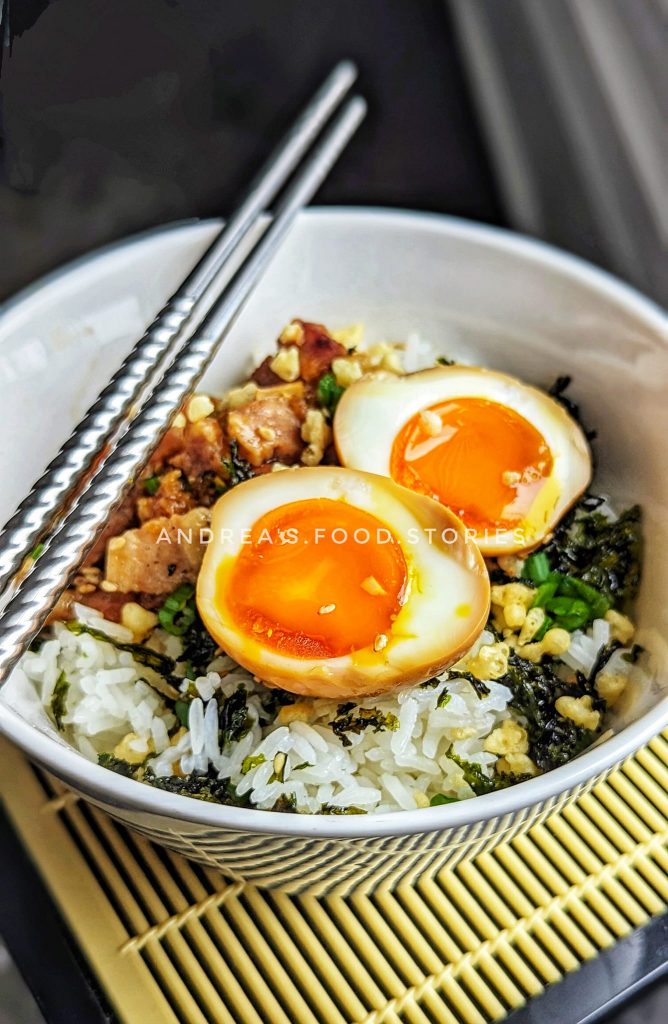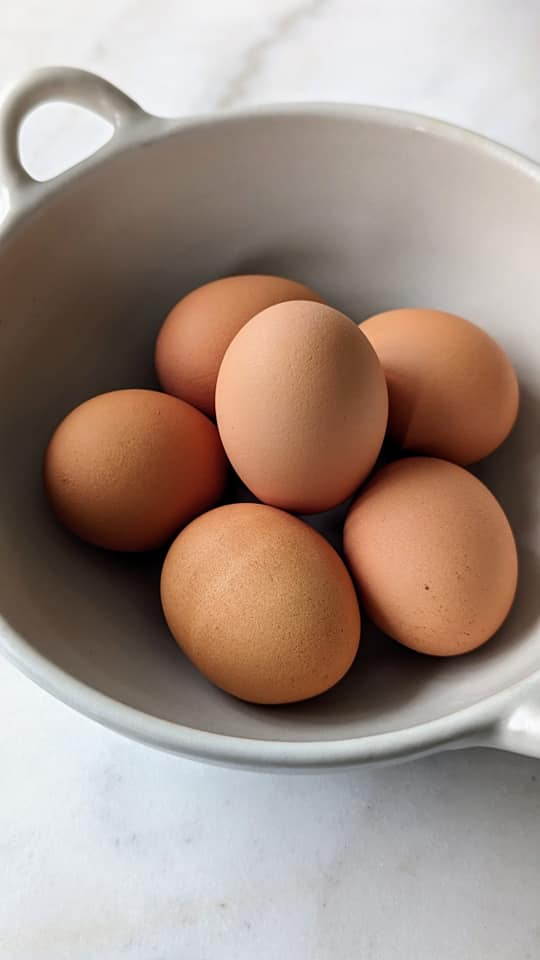
Mayak eggs, also known as Korean marinated eggs, are one of my favourite things to make. They’re super easy to whip up, making them my go-to for quick meals, especially in the mornings when the clock is not on my side. With basic ingredients and a tasty marinade, these eggs turn out soft and jammy. Give the recipe a try – it’s a perfect solution for a speedy and delicious meal and who says you can’t have a gourmet-ish breakfast when you’re racing against the clock?
What are Mayak Eggs?
So, what exactly are Mayak Eggs? Well, they’re these awesome Korean marinated eggs that are incredibly easy to make. Mayak Gyeran,” the Korean name for this dish, translates to “drug eggs,” capturing the irresistibly delicious and addictive nature of these eggs. The enticing flavour is bound to leave you wanting more. Picture this – soft, jammy eggs soaking up a delicious marinade overnight, creating flavourful bites one after another. They’re my personal favourite go-to for quick meals, especially in the mornings.
What makes these Korean marinated eggs even better is how versatile they are. They can elevate the flavour of pretty much any dish you’re making. Give it a try and cook up a batch!

How They Became a Kitchen Favourite
Mayak eggs have become a real hit. What’s behind their fame? Well, it’s a mix of things. It all starts with a simple combination of soy sauce, sugar, and a mix of seasonings. This transforms plain eggs into something flavourful that people couldn’t get enough of. The secret to their fame? Beyond their deliciousness, these eggs are a breeze to whip up at home. A straightforward recipe took them from an experiment to a must-have for quick and tasty meals.
Initially tied to street vendors and local markets, Mayak eggs were a quick and convenient snack that has now become a staple in Korean cuisine. The journey of Mayak eggs reflects the dynamic nature of Korean gastronomy. Starting as a simple portable snack, the recipe has transformed over generations, each adding its own twist.
Historically, Mayak eggs were straightforward – hard-boiled eggs coated in a savoury soy-based sauce. But as tastes evolved, so did the recipe. Over the years, Mayak eggs have changed as traditional recipes are passed down, and chefs put their unique spin on the dish. Creative innovations introduced new flavours, textures, and ingredients, resulting in the diverse Mayak egg variations we have today.
Ingredients and Preparation
When it comes to Mayak eggs, the main components are simple yet essential. Don’t use fresh eggs but slightly older eggs for easier peeling. Older eggs have a higher pH level and a larger air pocket, making the whites less likely to stick to the inner membrane and resulting in a smoother peeling process. Very fresh eggs, with tightly bound proteins, can be more challenging to peel. However, the difference in peelability is also influenced by factors such as egg temperature, boiling time, and cooling process.
The key flavour of these eggs comes from the savoury soy-based sauce, typically made with soy sauce, garlic, and a touch of sweetness. Additionally, a sprinkling of sesame seeds and chopped green onions often adds the finishing touch, enhancing both the taste and visual appeal of the eggs. One of the great things about Mayak eggs is their adaptability. There are so many ways you can make this dish your own! You could try different sauces, like a spicy gochujang glaze for a kick or a tangy sesame ginger dressing for some zing. If you’re craving a bit of crunch, toss some sesame seeds or crushed nuts on top to add texture. The best part? You can mix and match ingredients to make it exactly how you like it. Have fun and get creative!



Creating Mayak eggs at home is made even simpler with the help of my Thermomix, particularly its egg boiler setting. This feature ensures that my eggs consistently turn out just the way I like them – nice, soft, and jammy. The texture of Mayak eggs is a delightful combination of the creamy egg yolk and the slightly chewy exterior coated in the savoury sauce. Thanks to the precision and convenience of the Thermomix, achieving the perfect Mayak eggs at home has never been easier.
After boiling fresh eggs to perfection, the magic unfolds during the sauce preparation. A delightful blend of soy sauce, garlic, and a touch of sweetness comes together to form a savoury coating. After delicately peeling the eggs, they take a dip into the delectable sauce, allowing them to soak up the yummy flavours. The finishing flourish involves a generous sprinkle of sesame seeds and a scattering of chopped green onions, transforming the eggs into not just a tasty dish but also a visually appealing treat.


I really enjoy using lemongrass in my marinades. You probably know by now that I’m a big fan of lemongrass and tend to include it in most of my dishes. When I add lemongrass to the marinade for Mayak eggs, it gives them a fresh and citrusy kick. The lemongrass adds a lively flavour and a nice aroma. The key is to get the right amount, so the lemongrass enhances the flavours without taking over the delicious savoury taste of soy sauce and garlic. All in all, this little addition can make the Mayak eggs even more delicious, creating a richer and more exciting experience.
Ideal Accompaniments and Variations
Mayak eggs pair exceptionally well with a variety of accompaniments. Serve them alongside steamed rice for a simple and satisfying meal, or include them as part of a vibrant appetizer platter. The savoury nature of the eggs also makes them a perfect companion to fresh, crisp vegetables or a light salad.
Give your Mayak eggs a fun twist by adding some crushed nuts like peanuts or cashews for a satisfying crunch and extra texture. It’s a simple way to take them to the next level! It adds a tasty nutty flavour that pairs perfectly with the savoury goodness of the eggs. If you’re up for a sweet and savoury combo, give a Soy and Mirin glaze a shot. Mix soy sauce with sweet rice wine (mirin) for a delightful balance that enhances the overall taste. For some spiciness, add a kick by incorporating spicy elements like gochujang (Korean red pepper paste) or red pepper flakes into the marinade. Want to freshen things up? Throw in some chopped herbs like cilantro or parsley into the marinade. The herbal notes mix perfectly with the savoury richness, making every bite vibrant and full of flavour. Feeling a bit adventurous? Try Pickled Mayak Eggs by soaking them in a mix of soy sauce and vinegar. It gives the eggs a tangy kick, adding a zesty twist to the classic Mayak egg experience.
In the mornings, I enjoy pairing it with steamed rice, topped with seaweed, sesame seeds, and tempura bits to add a satisfying crunch.
Nutritional Value of Mayak Eggs
While Mayak eggs boast a delicious taste, it’s essential to be mindful of their nutritional aspects. These little snacks are full of high-quality protein from eggs, which helps with muscle growth and overall body upkeep. The soy-based sauce adds essential amino acids, giving a healthy touch to the tasty treat. However, keep in mind that the sauce also makes Mayak eggs high in sodium. While soy sauce brings flavour and antioxidants, it also adds to the overall sodium. Including Mayak eggs in a balanced diet is great, but if you’re watching your salt for heart health, be cautious about the sodium. Personally, I like to dilute the marinade with some water to reduce the saltiness.
My Encounter with Mayak Eggs
During my university days, I first came across Mayak eggs at my friend’s house. Her mom made some really delicious Mayak eggs and we often enjoyed them during our study sessions. The deliciousness of those eggs became a memorable part of my University days. Learning how to make Mayak eggs myself added a special touch to my culinary skills. The simplicity and deliciousness of Mayak eggs made them a go-to comfort food for me.
Tips and Tricks
- Fresh Eggs: Start with fresh eggs for the best flavour and texture.
- Boiling Time: When boiling the eggs, be precise with the timing. Overcooking can result in a dry texture. Around 8-10 minutes should yield the desired soft and jammy consistency. If using Thermomix, use the Medium Soft function.
- Add Vinegar to Boiling Eggs: Adding vinegar to boiling eggs serves multiple purposes. Firstly, it aids in the easy peeling of hard-boiled eggs by breaking down the eggshell and minimizing the likelihood of the egg whites sticking to it.
- Ice Bath: After boiling, immediately transfer the eggs to an ice bath. This helps in easy peeling and stops the cooking process, ensuring a creamy yolk.
- Peeling Technique: Gently tap the boiled eggs on a hard surface to crack the shell, then peel underwater or under running water. This makes peeling easier and cleaner.
- Marinating Time: Let the eggs marinate for at least 4 hours in the refrigerator. For a more intense flavour, marinate them overnight, but be careful, it could become really salty.
- Marinade Consistency: Adjust the marinade ingredients to your taste preferences. You can add a bit more sugar for sweetness or soy sauce for a saltier kick.
- Container Choice: Use a container or resealable bag for marinating, ensuring that the eggs are evenly coated with the marinade. Flip or shake the container/bag occasionally to distribute the flavours.
- Flavour Variations: Feel free to experiment with additional ingredients like ginger, rice vinegar, or a pinch of red pepper flakes to customize the flavours.
- Room Temperature Marinade: Before marinating, let the mixture reach room temperature. Cold marinade can solidify, making it harder for the flavours to infuse into the eggs.
- Garnishing: Enhance the presentation by garnishing with sesame seeds, chopped green onions, or a sprinkle of crushed red pepper for an extra kick.
- Use Tamari for Gluten-Free Option: If you’re following a gluten-free diet, consider using tamari instead of regular soy sauce in the marinade.
- Storage: Store the marinated eggs in an air tight container and in the refrigerator, and they should be consumed within a few days for the best taste and texture.
Mayak Eggs (Korean Marinated Eggs)
Mayak Eggs (Korean Marinated Eggs)
Ingredients
- 6 large eggs (room temperature)
- 2 tbsp white vinegar (for boiling eggs)
- 1/2 cup light soy sauce
- 1/2 cup water
- 2 tbsp mirin
- 1 tbsp honey or your choice of liquid sweetener
- 1 1 green onion, cut into small pieces
- 3 cloves garlic minced
- 2 tbsp toasted white sesame seeds
- 1 tsp sesame oil
- 2 stalks lemongrass (white part only) (optional)
- 1-2 tbsp Gochujang paste (optional)
- 2 chilli peppers (optional)
Instructions
- Place the eggs in a saucepan and cover with water. Add in vinegar. Bring to a boil, then reduce heat and simmer for about 8-10 minutes. Transfer the eggs to an ice bath to cool.
- Once cooled, peel the eggs carefully.
- In a bowl, mix soy sauce, mirin, honey, sesame oil, and minced garlic.
- Place the peeled eggs in a container or a resealable plastic bag. Pour the marinade over the eggs, making sure they are well coated. Garnish with sesame seeds and chopped green onions and lemongrass. Seal the container or bag and refrigerate for at least 4 hours, preferably overnight for a richer flavour.
- Garnish with sesame seeds and chopped green onions before serving. You can enjoy them on their own or as a topping for salads, rice bowls, or any dish you like.

Love the idea of adding in lemongrass! Will need to try that out!